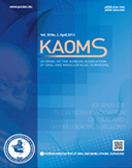Single institutional experience of geriatric maxillofacial trauma patients: a retrospective study
- 대한구강악안면외과학회
- 대한구강악안면외과학회지
- 제51권 제2호
-
2025.04102 - 107 (6 pages)
-
DOI : 10.5125/jkaoms.2025.51.2.102
- 0

Objectives: Geriatric maxillofacial trauma (GMT) is not an uncommon entity in maxillofacial surgery practice. The aim of the study was to document the experience with GMT cases in a single private dental college and hospital in an effort to uncover the etiology, prevalence, fracture sites, and various types of treatment in GMT. Materials and Methods: This was a retrospective study conducted at Saveetha Dental College and Hospital in Chennai. Data from patients diagnosed with maxillofacial trauma between January 2019 and December 2023 were retrieved from hospital records, and those aged ≥60 years were included in the study. Patients’ basic demographic details and the prevalence, etiology, fracture sites, and various treatments of GMT were recorded and analyzed. The collected data were entered into a structured database and analyzed using IBM SPSS Statistics ver. 23.0 (IBM). Results: A total of 867 cases were screened, and 37 (4.04%) GMT patients were finally included in the study. The mean age of the study population was 65±5 years, and there were six females and 31 males. A ground-level fall was the common etiology (n=17), and the most common site of fracture was the mandible (n=15). Open reduction and internal fixation (ORIF) was the most common treatment modality (n=24) among included cases. Conclusion: Although the prevalence of GMT was low, ground-level falls were a common reason for trauma; hence, geriatric patients require comprehensive care in home and outdoor settings. Enhanced anesthetic and surgical techniques have made ORIF a suitable treatment approach in the present era.
Ⅰ. Introduction
Ⅱ. Materials and Methods
Ⅲ. Results
Ⅳ. Discussion
Ⅴ. Conclusion
References
(0)
(0)